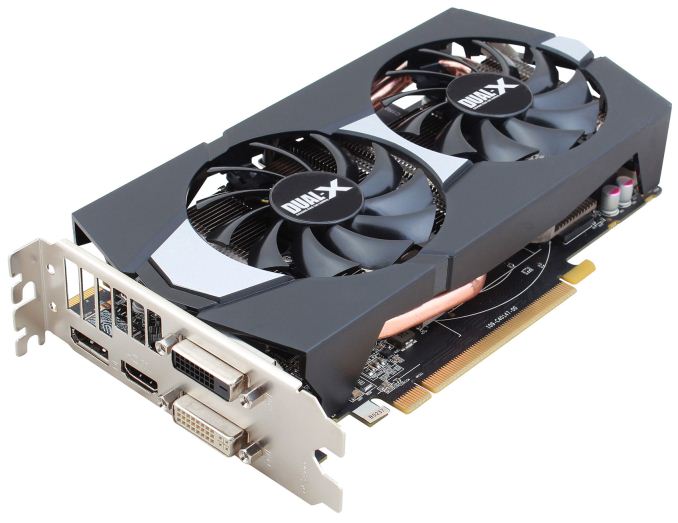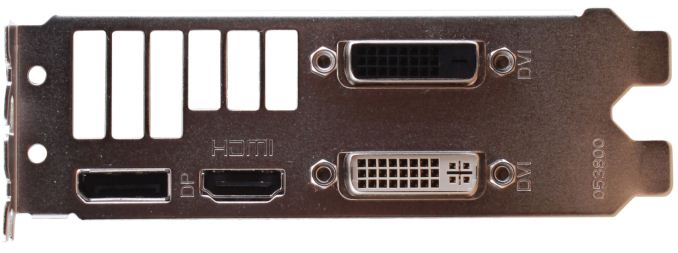The AMD Radeon R7 265 & R7 260 Review: Feat Sapphire & Asus
by Ryan Smith on February 13, 2014 8:00 AM ESTMeet The Sapphire Radeon R7 265
Since the R7 265 is a variant of the existing R7 270 series, AMD isn’t creating a reference card this time around. In lieu of that they have been sending the press Pitcairn cards reprogrammed to the 265 specification, which gives us something suitable to test but doesn’t necessarily represent what the final retail products will look like. For our sample we received a board based on Sapphire’s Radeon R9 270 Dual-X design.
Because we don’t know at this time whether this specific card will be a retail product or not, we’re not in a position to talk about it in depth. But we did want to discuss it briefly, as we expect most (if not all) retail R7 265 cards to be built in a similar manner, especially for the board partners reusing their existing R9 270 designs as was the case here.
Sapphire’s design is fairly typical for a 150W AMD card. Here Sapphire utilizes a compact form of their Dual-X cooler, relying on a pair of 75mm fans mounted over an aluminum heatsink, with a pair of copper heatpipes providing a connection between the heatsink and the Pitcairn GPU underneath. A baseplate brings the package together, providing cooling for the RAM and VRMs, relying on small grooves at various areas to function as a quasi-heatsink and improve convection. This means that it is of course an open air design, and while 150W is not trouble for most cases these days it does bear mentioning.
Sapphire’s Dual-X cooler runs 8.5” long, causing it to slightly overhang the 7.9” PCB. The card doesn’t feature a dedicated stiffening mechanism of any kind, but the baseplate is just large enough to provide the necessary rigidity on its own. Elsewhere the required 6pin PCIe power socket is located at far end of the PCB, orientated parallel to the PCB itself and slightly obscured by the card’s shroud; so you’ll need a bit more room behind the card to work in the necessary power cabling.
Finally, at the front end of the card we find half slot vent, coupled with AMD’s current generation I/O layout of 1x DisplayPort, 1x HDMI, and 2x DL-DVI. Notably, Sapphire has also added themselves to the pool of board partners with this design by using a wider grating spacing in an attempt to improve airflow, subdividing their vent into just 6 relatively large segments.













52 Comments
View All Comments
just4U - Thursday, February 13, 2014 - link
While you may be right... AMD/Ati does like throwing popular configurations into the mix.. The 265 reminds me a lot of the 4830 and while that card was fairly short lived it was a hot seller for them as it straddled two performance areas but came in at a nicer price point.jabber - Friday, February 14, 2014 - link
Indeed I swapped from being a longtime Nvidia user to AMD back in 2009 as I got fed up with Nvidia regurgitating the old 8800 chips three times in a row for the mid level.Stuff doesn't have to change radically performance wise but its nice to know new features are added and other things get revised and tweaked. A simple name change isn't enough really.
MrSpadge - Thursday, February 13, 2014 - link
I'm actually happy they're finally making use of that last digit in their 3-number scheme. From my point of view they could have ditched the X altogether and make the R9-270X an R9-275 (or whatever is appropriate). And speaking of R9: they could have given the R7 265 the rating R9 265 to more closely connect it with R9 270. Or just drop that prefix as well, if the numbers don't overlap anyway and the R9/7/3 is not related to features either!Speaking about the cards:
- boost clocks additional 25 MHz again? I have no idea why these are there. Make it 100+ MHz of leave it.
- 1.175 V for a mere 925 MHz? The chip should be able to do 1.0 GHz at ~1.0 V, maybe 1.10 V for guaranteed clocks
- same for R7 260 - that voltage is ridiculously high
Anyway, the cards themselves are fine (just like the 7000 series) and the coolers really fit them.
silverblue - Thursday, February 13, 2014 - link
The single GPU frame latency issue has been fixed for more than six months. I doubt it's going to become a problem again like with AMD's handling of 2D a while back.There are remarks concerning the availability of the R9 270 series and the inability for these parts to keep to their RRP, both of which may not be present if this was some sort of fanboy review.
Spuke - Thursday, February 13, 2014 - link
Has it been 6 months? I thought they recently fixed that problem.silverblue - Thursday, February 13, 2014 - link
It was fixed in Cat 13.8 Beta 1, dated 1st August.silverblue - Thursday, February 13, 2014 - link
My bad - that's when CrossFire had its first fix. Apparently, single-GPU was fixed beforehand, though I can't find which driver version it was.Solid State Brain - Thursday, February 13, 2014 - link
Anandtech: it would be interesting if you tested idle power consumption in multi monitor scenarios. I think you will find out some surprises.creed3020 - Thursday, February 13, 2014 - link
Excellent point!I had a friend with a 6950 and he was furious that his video card would never idle down in gpu/memory frequencies when he had a second monitor connected.
I personally have a 6850 and two 20" LCDs connected over DVI. I have not looked for the same behaviour but would not be surprised if it were the same.
Power efficiencies are out the window once the user chooses to go multi-monitor to be more productive.e
Solid State Brain - Thursday, February 13, 2014 - link
I have the same issue with my HD7770 to a lesser extent and my workaround for that is connecting my two secondary displays on the integrated Intel GPU. This saves a significant amount of power.